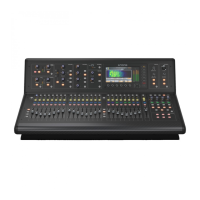64 M32 - Digital Console User Manual 65
send) to the six separate ¼“/RCA auxiliary outputs.
Since these six outputs can have a wide variety of signal paths assigned to them, they can be used for a wide variety of
tasks, such as:
1. Feeding an external eects processor when the internal eects are insucient.
2. Patching a specic console signal path to an outboard recorder.
3. Feeding the analogue or digital audio inputs of a nearby video recorder.
To make an assignment as described above, perform the following steps:
1. Adjust the rst rotary control to select to which auxiliary outputs to assign a source. Choices include
• Aux Out 1
• Aux Out 2
• Aux Out 3
• Aux Out 4
• Aux Out 5
• Aux Out 6
• AES/EBU (Digital) Out L
• AES/EBU (Digital) Out R.
2. Adjust the third control to select for coarse range:
• Insert
• Main (LRC)
• Mix Bus
• Matrix
• Direct Out
• Monitor.
3. Adjust the fourth control to select a specic signal path to feed the selected physical output. Choices include:
• Insert Point
• Main L
• Main R
• Main C/M
• Any of the 16 Mix Outputs
• Any of the six Matrix Outputs
• Any of the 32 Direct Outputs
• Any of the eight Auxiliary Outputs
• Any of the FX Direct Outputs
• Monitor L
• Monitor R
• Talkback.
4. Tap the fourth control to assign the selected output path, completing the process.
5. Adjust the fth control to select the signal tap point for the output assignment. Choices include:
• Input
• Pre-EQ
• Pre-Fader
• Post-Fader.
6. Tap the fth control to complete the signal tap point assignment.
p16 out
The ROUTING screen’s p16 out tab allows the user to route various console signal paths to the rear panel P16 Ultranet
output. This output allows for 16 channels of audio to be sent, in digital form, to various accessories such as a personal
monitoring distribution box.
Using the p16 out routing screen, the user can congure the P16 output to carry not only the main LR mix, but also
various audio ‘stems’ of audio material sources from a bus send mix, such as a stereo drum mix, stereo keyboards, guitars,
bass, vocals, etc. Musicians on stage would then be free to each craft their own personal mix of these musical stems, all
delivered from the FOH position to stage over a single Ethernet cable.
To select which audio signals are sent to the P16 bus, perform the following steps:
1. Adjust the rst rotary control to select for which of the 16 channels in the P16 bus you wish to select an audio
source.
2. Adjust the third control to select a category of audio source to send to the currently selected P16 channel. These
categories include:
• Insert
• Main (LRC)
• Mix Bus
• Matrix
• Direct Out
• Monitor.
3. Adjust the fourth control to select which specic signal path to feed to the currently selected P16 output. Choices
include:
• O
• Main L
• Main R
• Main C/M
• Any of the 16 Mix Outputs
• Any of the six Matrix Outputs
• Any of the 32 Direct Outputs
• Any of the eight Auxiliary Outputs
• Any of the FX Direct Outputs
• Monitor L
• Monitor R
• Talkback.
www.theaudiospecialists.eu

